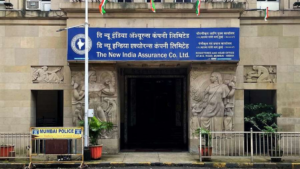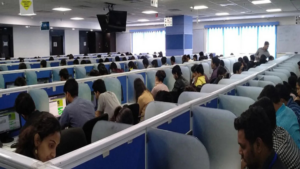Reasoning Questions for SBI PO MAINS 2019
Directions (1-5): Study the information carefully and answer the questions given below:
Six persons are sitting around a triangular table such that three of them sit at the corners and the rest on the middle of the side. The one who sits at the corner face away from the center and the one who sits at the middle of the side face towards the center. They also like different fruits. A sits second to the left of the one who likes banana. Only two persons sit between C and D. F sits second to the left of the one who likes grapes. C sits second to the right of B. Neither F nor C likes banana. The one who likes mango sits second to the right of the one who likes apple. D sits middle of the side and likes orange. A does not like guava.
Q1. Who among the following likes guava?
the one who likes banana. Only two persons sit between C and D. D sits middle
of the side and likes orange. Neither F nor C likes banana. There are two
possibilities-
of B. F sits second to the left of the one who likes grapes. The one who likes
mango sits second to the right of the one who likes apple. A does not like
guava. Here case 2 ruled out. The final arrangement is-
Q2. Who among the following sits immediate right of the one who likes banana?
Q3. How many persons sit between A and C, when counted right of A?
Q4. What is the position of D with respect to F?
Q5. Four of the following five from a group, which among the following does not belong to this group?
Directions (6-10): Study the given information and answer the questions:
When a number arrangement machine is given an input line of numbers, it arranges them following a particular rule. The following is an illustration of an input and its rearrangement.
Input: 45 39 64 53 89 74
Step I: 90 78 192 106 178 222
Step II: 9 15 12 7 16 6
Step III: 16 15 12 9 7 6
Step IV: 8 7.5 6 4.5 3.5 3
Step IV, is the last step of the above arrangement as the intended arrangement is obtained.
As per the rules followed in the given steps find out the appropriate steps for the given input:
Input: 68 49 26 96 53 15
Q6. What is the sum of the numbers at both the ends in step III of the given arrangement?
step. Let us understand the logic behind it- In each step the numbers are
arranged
number (input) are multiplied with 3 and all the odd numbers are multiplied
with 2.
49 26 96
53 15
288 106 30
18 7 3
7 6 3
3.5 3 2.5
Q7. Which element is 2nd to the right of the one which is 4th to the left element in step I?
step. Let us understand the logic behind it- In each step the numbers are
arranged
number (input) are multiplied with 3 and all the odd numbers are multiplied
with 2.
49 26 96
53 15
288 106 30
18 7 3
7 6 3
3.5 3 2.5
Q8. What is the products of the numbers which is 3rd from the left end in IV step and 2nd from the right end in III step of the given arrangement?
step. Let us understand the logic behind it- In each step the numbers are
arranged
number (input) are multiplied with 3 and all the odd numbers are multiplied
with 2.
49 26 96
53 15
288 106 30
18 7 3
7 6 3
3.5 3 2.5
Q9. What is the difference between the numbers which is second from the left end and third from the right end in step II?
step. Let us understand the logic behind it- In each step the numbers are
arranged
number (input) are multiplied with 3 and all the odd numbers are multiplied
with 2.
49 26 96
53 15
288 106 30
18 7 3
7 6 3
3.5 3 2.5
Q10. What is the difference of digits of the number which is fourth from the right in step I?
step. Let us understand the logic behind it- In each step the numbers are
arranged
number (input) are multiplied with 3 and all the odd numbers are multiplied
with 2.
49 26 96
53 15
288 106 30
18 7 3
7 6 3
3.5 3 2.5
Directions (11-13): Each of these questions is based on the following information:
(i) P % Q means P is the father of Q.
(ii) P @ Q means P is the sister of Q.
(iii) P $ Q means P is the brother of Q.
(iv) P * Q means P is the son of Q.
Q11. In the expression A * C % D @ B $ E, how is C related to E?
Q12. In the expression P @ R * T $ U % V, how is U related to P?
Q13. Which of the following expression shows E is aunt of G?
Directions (14-15): Study the given information and answer the questions:
Q14. Who among the following sister in law of R?
Q15. How G is related to F?
- Check the Study related Articles Here
- Study Notes for All Banking Exams 2018
- Bankers Adda Daily Questions for SBI PO, IBPS PO Clerk & Bank Exams










 NIACL AO Interview Schedule 2025-26 Out,...
NIACL AO Interview Schedule 2025-26 Out,...
 RBI Office Attendant Recruitment 2026 No...
RBI Office Attendant Recruitment 2026 No...
 OICL AO Exam Shift Timings 2025-26, Chec...
OICL AO Exam Shift Timings 2025-26, Chec...








